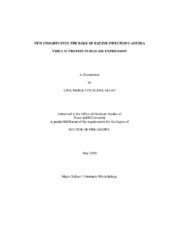| dc.description.abstract | Equine infectious anemia virus (EIAV) is an important animal model to study the
contribution of macrophages in viral persistence during lentiviral infections. EIAV is
unique amongst the lentiviruses in that it causes a rapid, rather than the very slow
disease progression, characteristic of other lentiviral infections. The accessory gene, S2,
unique to EIAV, is an important determinant in viral pathogenesis. A functional S2 gene
is required to achieve high-titer viremia and the development of disease in infected
horses. Despite its essential role, the mechanisms by which S2 influences EIAV
pathogenesis remain elusive. The goal of this research was to gain insight into the role of
S2 in pathogenesis. To accomplish this goal we: (i) Examined the effects of EIAV and
its S2 protein in the regulation of the cytokine and chemokine responses in macrophages,
(ii) Assessed the influence of EIAV infection and the effect of S2 on global gene
expression in macrophages and (iii) Identified host cellular proteins that interact with S2
as a starting point for the identification of host factors implicated in S2 function.
The results from this study provide evidence for a role of S2 in enhancing a proinflammatory
cytokine and chemokine response in infected macrophages. Specifically,
S2 enhances the expression of IL-1 alpha, IL-1 beta IL-8, MCP-2, MIP-1 beta, IP-10 and a newly
discovered cytokine, IL-34. Involvement of S2 in cytokine and chemokine dysregulation
may contribute to disease development by optimizing the host cell environment to
promote viral dissemination and replication. Microarray analyses revealed an interesting
set of differentially expressed genes upon EIAV infection. Genes affected by EIAV were
involved in the immune response, transcription, translation, cell cycle and cell survival.
Finally, we used the yeast two-hybrid system to identify S2 host cellular
interacting proteins. We identified osteosarcoma amplified 9 (OS-9) and proteasome 26S
ATPase subunit 3 (PSMC3) proteins as interacting partners of S2. Additional evidence is
needed to demonstrate the physiological relevance of these interactions in vivo.
In summary, the results from this study contribute towards our understanding of
the role S2 in disease expression and allow the formulation of new hypotheses as to the
potential mechanisms of action of S2 during EIAV infection. | en |


